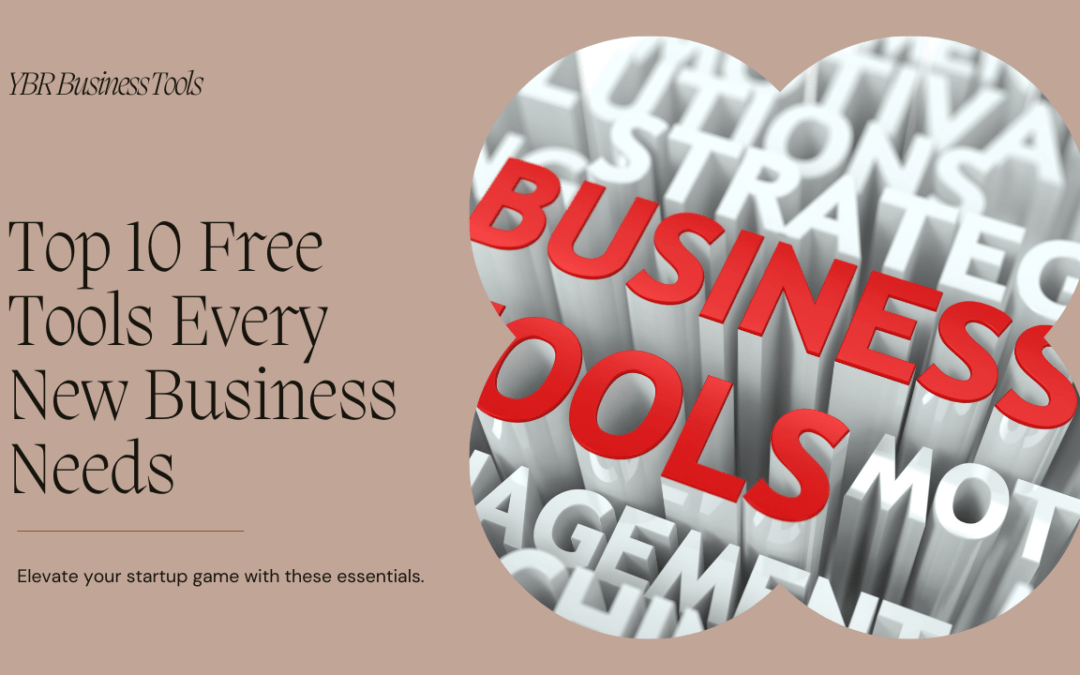
10 Must-Have Free Tools for Your First Year in Business
Let’s Take A Look At The Essential Free Business Tools for Your First Year
Starting your own business is an exhilarating journey, filled with dreams, ambitions, and a fair share of challenges. Imagine this: you’ve just launched your dream startup in Wollongong, and you’re navigating through the bustling Australian market. The excitement is palpable, but so is the pressure. According to the Australian Bureau of Statistics, almost About 20% of Australian new businesses fail their first year, then 60% go belly up within their first three years. These numbers fluctuate greatly based on their sector. For cash-strapped startups, finding the right tools that are both effective and free can be a game-changer. In this article, we’ll explore ten essential free tools that can streamline your operations, boost productivity, and set you up for success in your first year.
1. Business Plan Software
The Foundation of Your Business
A solid business plan is the backbone of any successful venture. It outlines your goals, strategies, and the roadmap to achieving them. But writing a business plan can be daunting without the right guidance.
Top Pick: Score Business Plan Template
Score Business Plan Template offers a free, comprehensive template that helps you organise your business plan efficiently.
Benefits
- Structured Planning: Helps you organise your ideas and strategies coherently.
- Easy-to-Use Template: Save time with a professional template tailored to different industries.
- Financial Forecasting: Provides tools to project revenue, expenses, and cash flow.
Insider Tip
Customise the template to reflect your unique business personality. Incorporate local market insights, especially if you’re targeting specific regions in Australia.
2. Accounting and Invoicing Software
Keeping Your Finances in Check
Managing finances is crucial, and as a new business owner, you can’t afford to let this slip. Proper accounting ensures you know where your money is going and helps you stay compliant with tax regulations.
Top Pick: Wave
Wave is a free accounting and invoicing software that offers comprehensive solutions for small businesses.
Benefits
- Automates Invoicing: Ensures timely billing and follow-ups.
- Tracks Expenses: Keeps all your receipts and expenses organised.
- Simplifies Tax Preparation: Makes end-of-year tax filing a breeze.
Cost: Free (Optional add-ons: Payments, Payroll starting from approx. AUD 20/month)
Insider Tip
Regularly review your financial reports to spot trends and adjust your strategies. For example, if your expenses are consistently higher in a particular month, investigate why and find ways to cut costs.
3. Project Management Tools
Staying Organised and On Track
With numerous tasks and deadlines, project management tools help keep everything under control. They ensure you or your team are on the same page and nothing slips through the cracks.
Top Pick: Trello
Trello offers a free version that is highly effective for project management and team collaboration.
Benefits
- Task Management: Break down projects into manageable tasks.
- Team Collaboration: Keep everyone informed and engaged.
- Deadline Tracking: Ensure projects stay on schedule.
Cost: Free (Optional Business Class upgrade approx. AUD 13.50/month per user)
Insider Tip
Use Trello to not only manage tasks but also to set up routine check-ins and feedback loops within your team. This fosters accountability and continuous improvement within your team.
4. Customer Relationship Management (CRM) Software
Building Strong Customer Relationships
In your first year, building a loyal customer base is paramount. CRM software helps manage customer interactions and data, ensuring you provide a personalised experience that keeps them coming back.
Top Pick: HubSpot CRM
HubSpot CRM offers a robust free version that caters to small businesses.
Benefits
- Centralises Customer Information: Keep track of all customer interactions in one place.
- Improves Customer Service: Access to detailed customer histories ensures better support.
- Boosts Sales: Helps identify potential leads and automate follow-ups.
Cost: Free (Optional add-ons: Marketing, Sales, and Service Hubs starting from approx. AUD 65/month)
Insider Tip
Leverage CRM data to create personalised marketing campaigns. For instance, if you notice a customer frequently purchases a certain product, send them tailored promotions and recommendations.
5. Marketing Automation Tools
Streamlining Your Marketing Efforts
Marketing is crucial for growth, but it can be time-consuming. Marketing automation tools handle repetitive tasks, allowing you to focus on strategy and creativity.
Top Pick: Mailerlite (Free Plan)
Mailerlite offers a free plan that includes essential marketing automation features for startups.
Benefits
- Email Marketing: Create, send, and track email campaigns effortlessly.
- Automated Workflows: Set up triggers and actions for personalised customer journeys.
- Analytics and Reporting: Measure the success of your campaigns and optimise them.
Cost: Free (Optional upgrades starting from approx. AUD 15/month)
Insider Tip
Experiment with A/B testing for your email campaigns. Small tweaks in subject lines or content can significantly impact open and conversion rates.
6. Social Media Management Tools
Harnessing the Power of Social Media
Social media is a powerful tool for building your brand and engaging with customers. However, managing multiple platforms can be overwhelming.
Top Pick: Agropulse (Free Plan)
Agropulse offers a free plan that helps you schedule posts and track engagement across various social media channels.
Benefits
- Schedule Posts: Plan your social media calendar in advance.
- Track Engagement: Monitor likes, shares, comments, and overall reach.
- Analyse Performance: Gain insights into what works and what doesn’t.
Cost: Free (Optional Pro plan starting from approx. AUD 21/month)
Insider Tip
Use Agropulse to not only post content but also to engage with your audience. Responding to comments and messages promptly builds a loyal community around your brand.
7. E-commerce Platforms
Selling Online Made Easy
If your business involves selling products, an e-commerce platform is essential. It simplifies the process of setting up an online store and managing sales.
Top Pick: WooCommerce
WooCommerce is a free, open-source e-commerce plugin for WordPress that offers extensive features to get your online store up and running. N.B. Will need a WordPress website.
Benefits
- Easy Store Setup: User-friendly interfaces to set up your store quickly.
- Secure Transactions: Ensure safe and secure payment processing.
- Inventory Management: Keep track of your stock levels and manage orders efficiently.
Cost: Free (Optional extensions vary, averaging approx. AUD 10-$100)
Insider Tip
Optimise your product descriptions with relevant keywords to improve search engine rankings. High-quality images and detailed descriptions, set up payment gateways etc, you can also enhance the shopping experience and reduce return rates.
8. Communication and Collaboration Tools
Enhancing Team Communication
Effective communication is key to a productive team. These tools facilitate seamless communication and collaboration, whether your team is in the same office or working remotely.
Top Pick: Slack (Free Plan)
Slack offers a free plan that is ideal for small teams needing real-time messaging, file sharing, and video conferencing.
Benefits
- Real-Time Messaging: Instant communication with your team.
- File Sharing: Share documents and collaborate on them in real time.
- Video Conferencing: Hold virtual meetings and stay connected.
Cost: Free (Optional Standard plan starting from approx. AUD 10/month per user)
Insider Tip
Set up dedicated channels for different projects or departments. This keeps conversations organised and ensures everyone has access to relevant information.
9. File Storage and Sharing Services
Keeping Your Files Safe and Accessible
Cloud storage solutions are a must for any business. They ensure your files are secure, backed up, and accessible from anywhere.
Top Pick: Google Drive (Free Plan)
Google Drive offers 15GB of free storage, along with collaborative features.
Benefits
- Cloud Storage: Access your files from any device with an internet connection.
- Easy File Sharing: Share files with team members and clients effortlessly.
- Document Collaboration: Work on documents simultaneously with your team.
Cost: Free (Optional Google One plans starting from approx. AUD 2.50/month for 100GB)
Insider Tip
Organise your files into clearly labeled folders and subfolders. This not only makes it easier to find documents but also ensures that everyone on your team can quickly locate the files they need.
10. Analytics and Reporting Tools
Making Data-Driven Decisions
Understanding your business data is crucial for making informed decisions. Analytics tools provide insights into various aspects of your operations, from website traffic to sales performance.
Top Pick: Google Analytics
Google Analytics is a free tool that provides powerful insights into your website traffic and user behavior.
Benefits
- Website Traffic Analysis: Understand where your visitors are coming from and what they’re doing on your site.
- Performance Insights: Track key performance indicators (KPIs) to gauge your business health.
- Data Visualisation: Create intuitive charts and graphs to present your data clearly.
Cost: Free
Insider Tip
Set up custom dashboards to monitor your most important metrics at a glance. Regularly reviewing these dashboards can help you spot trends and make proactive adjustments to your strategy.
So There You Have It!
Equipping your business with the right tools, free or otherwise in the first year can set you up for success and help you navigate the challenges of entrepreneurship. Assess your specific needs, choose tools that fit your business model, and don’t be afraid to invest in quality solutions when you’re able. By leveraging these tools, you’ll be better prepared to manage your operations, engage with customers, and drive growth.
Additional Tips
Evaluating and Choosing Tools
When selecting tools, consider the following:
- Scalability: Choose tools that can grow with your business.
- Integration: Ensure the tools can integrate with each other for seamless workflows.
- Cost: Balance functionality with affordability, especially in the early stages.
Scalability
As your business grows, your needs will evolve. Opt for tools that offer scalable plans, so you can upgrade features as needed without having to switch platforms.
We hope this guide helps you navigate your first year in business with confidence. Don’t forget to subscribe for more tips and guides on managing your business effectively. Download our Business Tools checklist of the tools mentioned for easy reference and start your journey to success today!
Wishing you epic business wins,
 Red
Red
Drop us a Line 📞 🗝 1300 902 588
Follow Us on Social ⏬⏬










